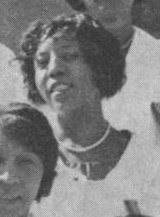Anna Johnson Dupree

Anna Johnson Dupree (November 27, 1891- February 19, 1977) was a Houston businesswoman and philanthropist.
Biography
Dupree was born in Carthage and grew up in a family where they picked cotton to make a living.[1] She was the "great-grandchild of a slaveholder and the grandchild of former slaves," and stories she heard about life in slavery had a deep affect on her.[2] Dupree grew up poor, living in a two-room house with her five siblings, her parents,[2] and her grandmother.[3] Dupree's mother "never permitted her to complain" of their poverty and "reminded her there were other children 'worse off' than she."[3]
As a young woman in 1904, she moved to Galveston where she earned a living as a domestic worker.[4] She was noticed for her sewing skills by a Mrs. Zula Kyle, who hired Dupree to work for her in Houston in 1911.[3] Dupree would return home to Galveston often to visit her family.[3]
She met her husband, Clarence Dupree, who was from Louisiana, in Galveston.[1] Anna Dupree would call Clarence a "very unusual person."[3] They were married in 1914, and moved to Houston in 1916.[3] The Duprees saved money by "living simply" and they began to invest what they could into real estate.[2] During World War I, Clarence was sent overseas to fight and during the conflict, he saved his money, returning to the United States with $100,000.[3]
During World War I, Anna Dupree continued to work and save money. She worked as a beautician and manicurist, and later, worked on her own, making beauty "house calls" which were so successful, white beauticians in Houston banded together to stop her.[3] Dupree was stopped from making house calls, but she vowed to create her own shop.[3] Dupree built her own beauty salon which also had a Turkish bath, a sweatbox and massage parlor in 1936.[2]
Together, the couple invested in other businesses and opened the Eldorado Ballroom in the Third Ward.[1] The Eldorado was built in 1939 and was one of the first black clubs and entertainment venues in Houston.[2] Previously, they had also opened the Pastime Theater in 1929.[3] Other businesses that they opened included a pharmacy, men's apparel store, paint store and a nightclub.[5]
Dupree "startled not only the community, but the whole United States with a gift of $20,000 for the construction of a building for underprivileged Negro children" in March of 1944.[6] This was considered one of the largest gifts ever given by a Southern black person at the time.[3] The place was named the Anna Dupree Cottage of the Negro Child Center and was located in the Fifth Ward.[2]
In 1952, the Duprees opened the Eliza Johnson Home for Aged Negros.[4] The home was named in memory of Dupree's mother.[3] Anna Dupree donated property in Highland Heights for the Eliza Johnson Home.[2] Dupree would make fruit cobblers and fruit and boiled dumplings for the "old timers."[6]
Dupree and her husband gave money to the Houston College of Negroes (Now Texas Southern University) and the United Negro College Fund.[4] The couple gave $11,000 in 1946 to the Houston College of Negroes so that the college could construct its first permanent building.[2] They also raised money for Camp Robinhood, the first black Girl Scout camp,[4] and sponsored the first Little League baseball team for blacks in Houston.[2]
When her husband died in 1959, Dupree's "health declined" and eventually she moved into the Eliza Johnson Home.[2] She died there on February 19, 1977 and her body was donated to medical research.[2]
References
- 1 2 3 Steptoe, Tyina (2015). Houston Bound: Culture and Color in a Jim Crow City. University of California Press. p. 170. ISBN 9780520958531.
- 1 2 3 4 5 6 7 8 9 10 11 Jones, Nancy Baker (12 June 2010). "Dupree, Anna Johnson". Handbook of Texas Online. Texas State Historical Association. Retrieved 13 February 2016.
- 1 2 3 4 5 6 7 8 9 10 11 12 Jones, Yvette (November 1976). "Seeds of Compassion". The Texas Historian. 37: 16–21. Retrieved 13 February 2016.
- 1 2 3 4 "Anna Dupree Collection MSS.0110". Texas Archival Resources Online. Retrieved 13 February 2016.
- ↑ Pruitt, Bernadette (2013). The Other Great Migration: The Movement of Rural African Americans to Houston, 1900-1941. Texas A&M University Press. p. 277. ISBN 9781603449489.
- 1 2 Winegarten, Ruthe; Humphrey, Janet G.; Werden, Frieda (1996). Black Texas Women: A Sourcebook. University of Texas Press. pp. 173–174. ISBN 9780292791008.